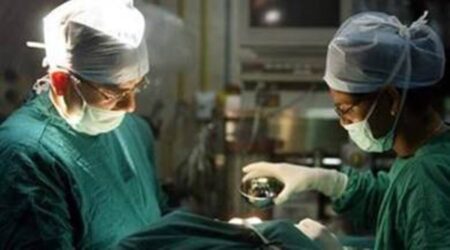Headache Disorders in Indore
Jupiter Hospital: Finding Relief and Expert Care at Headache Disorders Hospital in Indore
Jupiter Hospital is a leading Headache Disorders Hospital in Indore that presents specialised care for individuals grappling with various forms of headache disorders. Headache, a prevalent medical ailment, manifests as pain or discomfort in the head, scalp, or neck region, impacting a significant portion of the population.
Chronic Daily Headache
Chronic Daily Headache (CDH), a subtype of headache disorders, is defined by persistent headaches occurring for 15 or more days per month or lasting for at least three months. Managing Chronic Daily Headaches poses a significant challenge due to their frequency and intensity. Recent epidemiological studies reveal that nearly 5% of the general population experiences daily headaches.
Primary headache syndromes are commonly observed among patients with persistent headaches. Headache remains the primary complaint prompting individuals to seek neurological evaluation. While many headaches originate from benign causes, some may stem from severe or even life-threatening conditions.
Team
Looking for the Headache Disorders in Indore
Headaches encompass a diverse array of types, each distinguished by unique characteristics and underlying causes. Common classifications include:
- Tension headaches: These are characterized by a persistent, dull ache around the head or neck.
- Migraine headaches: Intense, pulsating pains lasting hours or days, migraines are often accompanied by light and sound sensitivity and vomiting.
- Cluster headaches: Rare but severe, cluster headaches occur in cyclical patterns, and are marked by intense pain lasting weeks or months.
- Sinus headaches: These result from sinusitis, present with pain and pressure around the eyes, cheeks, and forehead.
- Rebound headache: This is caused by excessive use of pain medication, leading to daily or near-daily dull, persistent headaches.
- Hormone headaches: Such headaches are associated with hormonal fluctuations during menstrual cycles, pregnancy, or menopause in women.
- Thunderclap headache: A sudden, severe headache signalling potentially serious conditions like a ruptured blood vessel or brain aneurysm, this type of headache needs urgent medical attention.
- Hemicrania continua: A rare chronic headache type, it is characterized by continuous pain on one side, often relieved by indomethacin.
- Primary stabbing headaches: Brief, sharp pains, primary stabbing headaches are also known as "ice pick headaches" which occur anywhere on the head without major concern.
- Primary exertional headaches: These occur during or after physical activity, lasting briefly but with severe intensity.
- Chronic paroxysmal hemicrania: This causes an intense, stabbing pain on one side of the head, accompanied by tearing and nasal congestion, lasting minutes to hours.
- Medication overuse headaches: These result from excessive pain medication use, leading to increased frequency and severity of headaches.
Certain symptoms associated with headaches demand immediate attention to rule out serious underlying conditions. These symptoms include:
- Fever, neck stiffness, personality changes, or abnormal neurological symptoms, which necessitate prompt evaluation.
- A sudden, new, or different headache in individuals over 50 years old.
- Headaches developing within minutes, commonly known as "thunderclap" headaches.
- Confusion accompanying headaches, possibly indicating encephalitis.
- Inability to move a limb, abnormalities on neurological examination, mental confusion, or being awakened by headaches.
- Headaches worsening with changing posture, exertion, coughing, or straining.
- Visual abnormalities, jaw pain on chewing (jaw claudication), or visual loss.
- Signs of an irritated brain surface, such as a severely stiff neck (a sign of meningitis) or sudden spike of pain with head movement.
- A history of serious diseases involving the head or brain, like AIDS or cancer, with sudden changes in headache patterns.
- Headaches accompanied by neurological symptoms like weakness, dizziness, sudden loss of balance, numbness or tingling, paralysis, speech difficulties, mental confusion, seizures, personality changes, inappropriate behavior, or vision changes.
- Headaches with unexplained fever, shortness of breath, or weakness on one side of the body.
- Headache pain waking you at night (cluster headache or alarm clock headache).
- Severe nausea and vomiting accompanying headaches (migraine).
- Headaches occurring after head injury or accident.
- Nontrivial head trauma or convulsions.
- Headaches relentlessly worsening over days or weeks.
- Blood pressure higher than 180/115.
Migraine or headache symptoms requiring attention
While not immediately urgent, certain migraine or headache symptoms warrant attention from a headache specialist. These include:
- Inability to function normally at work or during leisure activities due to headache severity.
- Non-prescription drugs providing minimal relief.
- Experiencing three or more headaches per week.
- Headaches worsening over time and failing to subside.
- Daily or near-daily reliance on pain relievers for headaches.
- Needing more than two to three doses of over-the-counter medications weekly for relief.
- Noticing a recent change in headache symptoms despite a history of headaches.
Headaches can stem from various factors, including:
- Tension: Stress, poor posture, and anxiety often contribute to tension headaches.
- Hormonal Changes: Fluctuations in oestrogen levels during menstruation or menopause can trigger migraines in susceptible individuals.
- Environmental Triggers: Bright lights, loud noises, and strong odours are common environmental factors that can provoke headaches.
- Underlying Medical Conditions: Headaches may manifest as symptoms of medical issues such as sinusitis, high blood pressure, or even brain tumours.
To pinpoint the root cause of a headache, your healthcare provider may conduct a comprehensive assessment, which typically includes:
- Physical Examination: Your doctor will perform a thorough physical examination and inquire about your symptoms, medical history, and lifestyle factors.
- Diagnostic Tests: Depending on the evaluation, your doctor may recommend additional tests to rule out underlying conditions. These tests may include:
- CT scan or MRI: Imaging tests to detect any abnormalities in the brain that might be triggering headaches.
- Blood Tests: Examination of blood samples to identify any underlying medical conditions contributing to headaches.
- Lumbar Puncture: A procedure involving the extraction of cerebrospinal fluid from the spine to assess for signs of infection or other neurological conditions.
- Electroencephalogram (EEG): Assessment of brain activity to identify potential seizure-related causes of headaches.
- Sinus X-ray: Imaging to diagnose sinusitis, a common cause of headaches.
By conducting a thorough evaluation, healthcare providers can determine the most appropriate course of treatment to alleviate headaches and address any underlying health concerns.
Several factors may heighten the likelihood of developing headaches:
- Genetics: Migraines and cluster headaches often have a hereditary component, with a predisposition passed down through generations.
- Gender: Women exhibit a higher susceptibility to migraines compared to men, potentially due to hormonal influences.
- Age: Migraines commonly commence during adolescence and peak in the 30s, whereas cluster headaches are prevalent among men over 30.
- Lifestyle Influences: Poor dietary habits, inadequate sleep, and sedentary lifestyles can elevate the risk of experiencing headaches.
- Environmental Triggers: Exposure to second-hand smoke, pollution, and certain chemicals may trigger or exacerbate headache episodes.
Understanding these risk factors enables individuals to adopt preventive measures and seek appropriate management strategies for their headaches. For those seeking effective Headache Disorders treatment in Indore, our specialised facility offers comprehensive care tailored to address various forms of headaches, including Chronic Daily Headaches.
Patients Speak
Hear the heartwarming stories of patients overcoming difficult afflictions
















 View Map
View Map Book an Appointment
Book an Appointment Find a Doctor
Find a Doctor Health Check-up
Health Check-up




 Find a Doctor
Find a Doctor Health Checkup
Health Checkup Book an Appointment
Book an Appointment